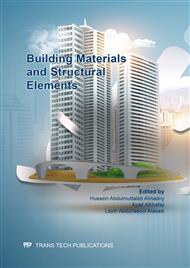[1]
Hewayde, E., Nehdi, M., Allouche, E., and Nakhla, G. 2006. Effect of Geopolymer Cement on Microstructure, Compressive Strength and Sulfuric Acid Resistance of Concrete. Mag. of Conc. Research, 58, 5: 321-331.
DOI: 10.1680/macr.2006.58.5.321
Google Scholar
[2]
Skelton, R. 1938. Cement-Sawdust Concrete for Poultry House and Dairy Barn Floors. Extension Circular 217. University of New Hampshire Extension Service.
Google Scholar
[3]
Hussein, G., Memon, R., Kubba, Z., Sam, A., Asaad, M., Mirza, J. and Memon, U. 2019. Mechanical, Thermal and Durable Performance of Wastes Sawdust as Coarse Aggregate Replacement in Conventional Concrete. J. Teknologi, 81, 1: 151-161.
DOI: 10.11113/jt.v81.12774
Google Scholar
[4]
Osei, D. and Jackson, E. 2016. Compressive Strength of Concrete Using Sawdust as Aggregate. Int. J. of Science & Engineering. Research. 7, 4: 1349- 1352.
Google Scholar
[5]
Oltouge, F. 2010. Investigation on Sawdust and Palm Kernel Shells as Aggregate Replacement. APRN J. of Engineering. 5,4: 7-13.
Google Scholar
[6]
Adebakin, I., Adeyemi, A., Adu, J., Ajayi, F., Lawal, A. and Ogunrinola, O.(2012. Uses of Sawdust as Admixture in Production of Low Cost and Light Weight Hollow Sandcrete Blocks. American J. of Sci. & Industrial. Res. 3: 458-463.
DOI: 10.5251/ajsir.2012.3.6.458.463
Google Scholar
[7]
Lui, Y., Dawe, J. and Christie, G. 2005. Evaluation of Lightweight Sawdust Concrete Units. 10th Canadian Masonry Sym., Banff, Alberta.
Google Scholar
[8]
Udoeyo, F., Inyang, H., Young, D. and Oparado, E. 2006. Potential of Wood Ash Waste as an Additive in Concrete. J. in Materials in Civil Engineering, 18, 4: 605-611.
DOI: 10.1061/(asce)0899-1561(2006)18:4(605)
Google Scholar
[9]
Elinwa, A., Ejeh, S. and Mamuda, A. 2008. Assessing of the fresh concrete properties of self-compacting concrete containing sawdust ash. Construction and Building Materials. 22: 1178-1182.
DOI: 10.1016/j.conbuildmat.2007.02.004
Google Scholar
[10]
Etiegni, L. and Campbell, A. 1991. Physical and Chemical Characteristics of Wood Ash. J. of Bioresources Technology. 37: 173-178.
Google Scholar
[11]
Maharani, R., Yutaka, T., Yajima, T. and Minoru, T. 2010. Scrutiny of Physical Properties of Sawdust from Tropical Countries Wood Species: Effect of Different Mills and Sadust Particle Size. J. of Forestry Res. 7, 1: 20-32.
DOI: 10.20886/ijfr.2010.7.1.20-32
Google Scholar
[12]
Karade, S. and Aggarwal, L. 2005. Cement Bonded Lignocellulosic Composites for Building Applications. Metal Materials and Processes. 117, 2: 129-140.
Google Scholar
[13]
Wang, B., Wang, H. and Lu, X. 2014. Wood-Cement Compatibility Review. Wood Research. 59, 5: 813-825.
Google Scholar
[14]
Del Menezzi, C., Castro, V. and Souza, M. 2007. Production and Properties of Medium Density Wood Cement Boards Produced with Oriented Strands and Silica Fume. Ciencia y Technologia 9, 2: 105-115.
Google Scholar
[15]
Usman, D., Indusuyi, F., Ojo, E. and Simon, D. 2012. The Use of Sawdust and Palm Kernel Shells as Substitute of Fine and Coarse Aggregates in Concrete Construction in Developing Countries. J. of Chemical, Mechanical and Engineering Practice. 2, 3: 51-62.
Google Scholar
[16]
Lee, A., Hong, Z. and Phillips, D. 1987. Effect of Cement/Wood Ratios and Wood Storage Conditions on Hydration Temperature, Hydration Time and Compressive Strength of Wood-Cement Mixtures. Wood and Fiber Science. 19, 3: 262-268.
DOI: 10.1007/bf00770695
Google Scholar
[17]
Okoroafor, S., Ibearugbulam, O., Onukwugha, E., Anyaogu, L. and Adah, E. 2017. Structural Characteristics of Sawdust-Sand-Cement Composite. Int. J. of Advancements in Research & Technology. 6, 1: 173-180.
Google Scholar
[18]
Ahmed, W., Khushnood, A., Memon, S., Ahmed, S., Baloch, W., and Usman, M. 2018. Effective Use of Sawdust for the Production of Eco-friendly and Thermal Energy Efficient Normal Weight Concretes with Tailored Fracture Properties. J. of Cleaner Production. 184: 1016-1027.
DOI: 10.1016/j.jclepro.2018.03.009
Google Scholar
[19]
Vaickelionis, G. and Vaickelioniene. 2006. Cement Hydration in the Presence of Wood Extractives and Pozzolan Mineral Additives. Ceramics-Silikaty. 50, 2: 115-122.
Google Scholar
[20]
Miller, D. and Moslemi, A. 1991. Wood Cement Composites: Effect of Model Compounds on Hydration Characteristics and Tensile Strength. Wood and Fiber Science. 23, 4: 472-482.
Google Scholar
[21]
Gartner, E., Young, J., Damido, D. and Jawed, I. 2002. Hydration of Portland Cement, Structure and Performance of Cement. Spoon Press, London, E&FN: 57-113.
Google Scholar
[22]
Zhou, M. and Li, Z. 2012. Light Weight Wood Magnesium Oxychloride Cement Composite Building Products Made by Extrusion. Construction and Building Materials. 27, 1: 382-389.
DOI: 10.1016/j.conbuildmat.2011.07.033
Google Scholar


